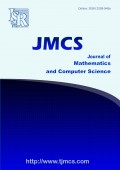A general model of non-communicable diseases and its qualitative analysis without finding the eigenvalues
Volume 24, Issue 1, pp 73--81
http://dx.doi.org/10.22436/jmcs.024.01.07
Publication Date: January 13, 2021
Submission Date: April 16, 2020
Revision Date: September 16, 2020
Accteptance Date: November 20, 2020
-
2449
Downloads
-
4241
Views
Authors
Auni Aslah Mat Daud
- Faculty of Ocean Engineering Technology and Informatics, University Malaysia Terengganu, Kuala Nerus, 21030, Malaysia.
Toh Cher Qing
- Faculty of Ocean Engineering Technology and Informatics, University Malaysia Terengganu, Kuala Nerus, 21030, Malaysia.
Abstract
Obtaining the analytical solutions of a linear ordinary differential equations is impossible without finding the eigenvalues. In this study, a general linear model of non-communicable disease (NCD) is formulated using the compartmental analysis and its qualitative properties are analyzed without finding the eigenvalues. NCDs are diseases which are not passed from person to person. The proof of the qualitative properties of the general model including the existence and uniqueness of its solution and equilibrium, and the positivity and boundedness of its solutions are provided. The global stability of the general model is analyzed using the theorem of compartmental matrix and Lyapunov function. It is found that the model has one unique non-negative equilibrium which is globally exponentially stable. As a real-world example, the general model and its qualitative analysis are implemented to a NCD, namely venous thromboembolism (VTE) among pregnant and postpartum women. VTE is selected in this study as it is a major global health burden due to its association with disability and lower quality of life and death.
Share and Cite
ISRP Style
Auni Aslah Mat Daud, Toh Cher Qing, A general model of non-communicable diseases and its qualitative analysis without finding the eigenvalues, Journal of Mathematics and Computer Science, 24 (2022), no. 1, 73--81
AMA Style
Mat Daud Auni Aslah, Qing Toh Cher, A general model of non-communicable diseases and its qualitative analysis without finding the eigenvalues. J Math Comput SCI-JM. (2022); 24(1):73--81
Chicago/Turabian Style
Mat Daud, Auni Aslah, Qing, Toh Cher. "A general model of non-communicable diseases and its qualitative analysis without finding the eigenvalues." Journal of Mathematics and Computer Science, 24, no. 1 (2022): 73--81
Keywords
- Mathematical modelling
- qualitative analysis
- non-communicable disease
- venous thromboembolism
- global stability
- compartmental analysis
MSC
References
-
[1]
D. H. Anderson, Compartmental modeling and tracer kinetics, Springer-Verlag, Berlin (1983)
-
[2]
A. Boutayeb, E. H. Twizell, K. Achouayb, A. Chetouani, A mathematical model for the burden of diabetes and its complications, Biomed. Eng. Online, 3 (2004), 8 pages
-
[3]
F. Brauer, J. A. Nohel, The qualitative theory of ordinary differential equations: An introduction, Dover Publications, New York (1969)
-
[4]
J. Drife, Thromboembolism: reducing maternal death and disability during pregnancy, Br. Med. Bull., 67 (2003), 177--190
-
[5]
K.-J. Engel, R. Nagel, One-Parameter Semigroups for Linear Evolution Equations, Springer-Verlag, New York (2000)
-
[6]
G. P. Garnett, An introduction to mathematical models in sexually transmitted disease epidemiology, Sex. Transm. Infect., 78 (2002), 7--12
-
[7]
H. W. Hethcote, The mathematics of infectious diseases, SIAM Rev., 42 (2000), 599--653
-
[8]
J. A. Jacquez, C. P. Simon, Qualitative theory of compartmental systems, SIAM Rev., 35 (1993), 43--79
-
[9]
A. H. James, Venous thromboembolism in pregnancy, Arterioscler. Thromb. Vasc. Biol., 29 (2009), 326--331
-
[10]
S. Liu, J. Rouleau, K. S. Joseph, R. Sauve, R. M. Liston, D. Young, M. S. Kramer, Epidemiology of pregnancy-associated venous thromboembolism: a population-based study in Canada, J. Obstet. Gynaecol. Can., 31 (2009), 611--620
-
[11]
A. A. Mat Daud, Mathematical modeling and stability analysis of population dynamics, In Dynamical Systems, Bifurcation Analysis and Applications, Springer, Singapore, 2018 (295), 3--13
-
[12]
A. A. Mat Daud, Some issues on the mathematical modeling of population dynamics using differential equations, Int. J. Math. Comput. Sci., 15 (2020), 501--513
-
[13]
A. A. Mat Daud, C. Q. Toh, S. Saidun, A mathematical model to study the population dynamics of hypertensive disorders during pregnancy, J. Interdiscip. Math., 22 (2019), 433--450
-
[14]
A. A. Mat Daud, C. Q. Toh, S. Saidun, Development and analysis of a mathematical model for the population dynamics of Diabetes Mellitus during pregnancy, Math. Models Comput. Simul., 12 (2020), 620--630
-
[15]
P. H. Reitsma, H. H. Versteeg, S. Middeldorp, Mechanistic view of risk factors for venous thromboembolism, Arterioscler. Thromb. Vasc. Biol., 32 (2012), 563--568
-
[16]
C. I. Siettos, L. Russo, Mathematical modeling of infectious disease dynamics, Virulence, 4 (2013), 295--306
-
[17]
A. A. Sultan, J. West, L. J. Tata, K. M. Fleming, C. Nelson-Piercy, M. J. Grainge, Risk of first venous thromboembolism in and around pregnancy: A population-based cohort study, Br. J. Haematol., 156 (2012), 366--373
-
[18]
R. A. Virkus, E. C. L. Løkkegaard, T. Bergholt, U. Mogensen, J. Langhoff-Roos, O. Lidegaard, Venous thromboembolism in pregnant and puerperal women in Denmark 1995--2005: A national cohort study, Thromb. Haemost., 106 (2011), 304--309
-
[19]
S. A. Wirkus, R. J. Swift, A course in ordinary differential equations (2nd ed.), CRC Press, New York (2004)

